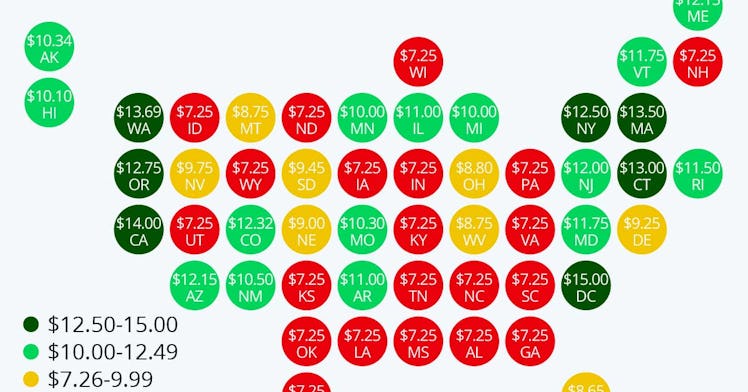Map of Minimum Wages By State Shows How Badly We Need $15/Hour
Raising the federal minimum wage is as important as ever.

As many Democrats are trying to make a $15-an-hour federal minimum wage a reality and include it in the new COVID-19 relief bill, a map from Statista reinforces just how vital that wage increase would be for Americans. According to Statista, which pulled data from the National Conference of State Legislatures, only 29 states and Washington D.C. have a minimum wage that exceeds the federal minimum wage of $7.25 per hour.
The data visualization illustrates that five states (Louisiana, Alabama, South Carolina, Tennessee, and Mississippi) have not yet adopted statewide minimum wages. Georgia and Wyoming currently have statewide minimum wages below $7.25, but effectively those two states plus the five that have not adopted statewide minimum wages all abide by the federal minimum wage.
The Statista chart shows which states have higher minimum wages than others. Currently, D.C. has the highest minimum wage at $15 per hour, but a few other states have minimum wages that approach D.C’s. As per the map, California has the second-highest, at $14 minimum wage. Washington clocks in at $13.69, Massachusetts pays $13.50 and Connecticut comes in at $13. These are not terrible minimum wages when divorced from other data — like how much money it costs to rent a one-bedroom apartment in each of these states and cities in them. But the map shows just how much even the most progressive states when it comes to wage minimums could use bumping up a bit.
And while numbers like those states’ are a step in the right direction, a whopping 21 states in total still only pay the federal minimum wage, which hasn’t been updated in over a decade, as inflation and the cost of living has astronomically risen across the country.
Add that to the fact that millions and millions of Americans have lost their jobs during the pandemic and that almost half of all Americans actually work low-wage jobs and are otherwise struggling financially, it would seem that increasing the federal minimum wage is as important as ever. After all, an economy is only as healthy as those who struggle the most — and in a country where almost half of Americans can’t afford an emergency expense of $400 or more — the minimum wage hike would change everything.
In many ways, time is of the essence. A new study from researchers at Syracuse University found that raising the minimum wage can majorly reduce the infant mortality rates for kids in large cities. According to their research, every time the minimum wage increases by one dollar, the infant mortality rate decreases by 1.8% in large cities. So, a $15 minimum federal wage would not only help struggling Americans — it would also save lives.
This article was originally published on